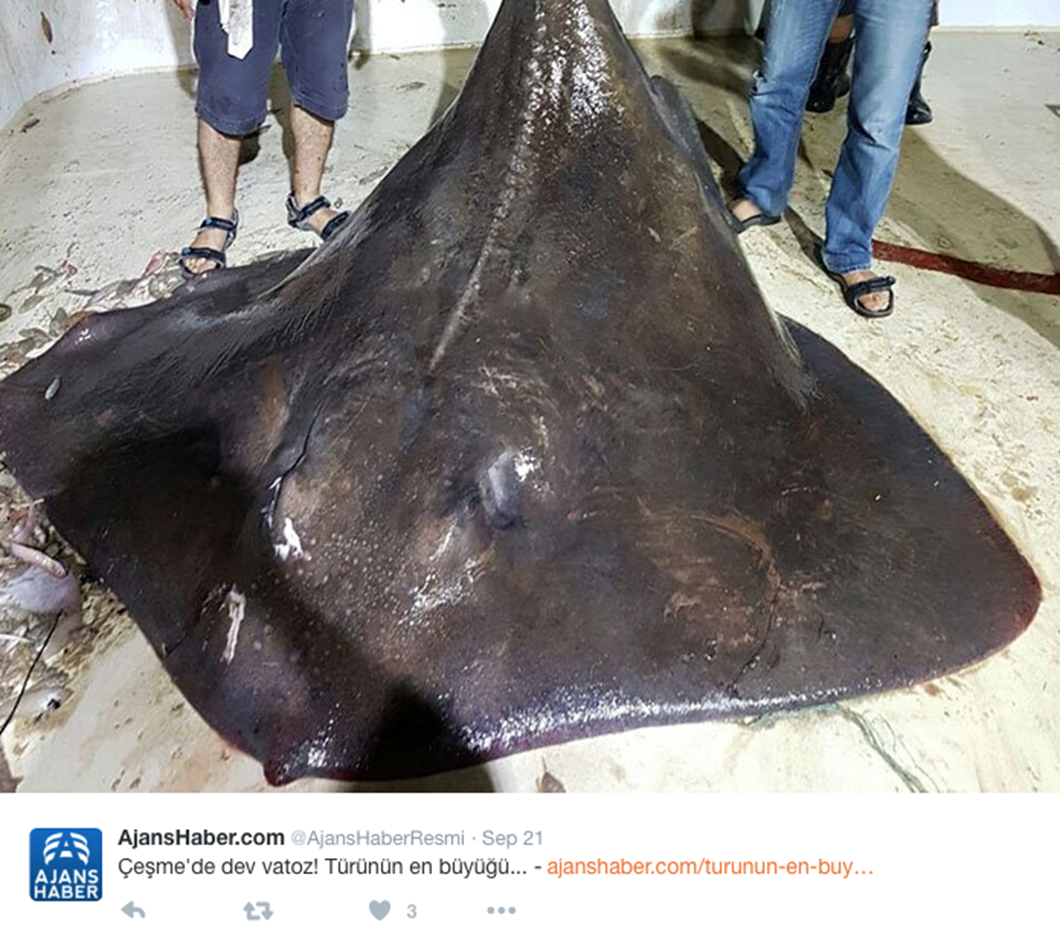During a recent survey off the coast of Turkey, scientists hauled up one of the largest saltwater stingrays ever found. The fish's "wingspan" was reportedly 2.21 metres – if confirmed, that size would surpass the previous catch record by nearly a metre!
The 450-kilogram common stingray (Dasyatis pastinaca) was caught near Turkey's western Izmir province by Ege University Department of Aquaculture researcher Dr lker Aydin and his graduate students. The team had been conducting a survey of deep-sea fishes in the region, and netted the ray some 100 metres below the surface.
Once it was aboard the research vessel, a pipe was used to keep oxygenated water flowing over the ray's gills while the team conducted their workup, a process that involves various measurements and observations. After a few short minutes, the animal was about ready for release – but something caught Aydin's eye when he lifted the ray's tail to determine the sex: the animal was giving birth. "It was a big surprise for us," he told the Andelou Agency.
This isn't the first time we've seen a ray give birth under strange circumstances. Sharks and rays are very sensitive to stress, and it's not uncommon for females to go into labour after being caught (either on a line, or by a predator).
"I think it is a very reasonable assumption that if the neonates are close to term, the female may choose to give birth in an attempt to give the offspring a chance of escaping," Thomas Farrugia, a PhD candidate at University of Alaska Fairbanks, who specialises in skates and rays, tells us. "It's a very surprising turn of events in most cases, and every time I have witnessed it, the offspring were pretty far along in their development."
This was the case for the researchers in Turkey, too. The eight pups born on the vessel were delivered without a visible yolk sac, which indicates that the babies were likely very close to term.
Once it was aboard the research vessel, a pipe was used to keep oxygenated water flowing over the ray's gills while the team conducted their workup, a process that involves various measurements and observations. After a few short minutes, the animal was about ready for release – but something caught Aydin's eye when he lifted the ray's tail to determine the sex: the animal was giving birth. "It was a big surprise for us," he told the Andelou Agency.
This isn't the first time we've seen a ray give birth under strange circumstances. Sharks and rays are very sensitive to stress, and it's not uncommon for females to go into labour after being caught (either on a line, or by a predator).
"I think it is a very reasonable assumption that if the neonates are close to term, the female may choose to give birth in an attempt to give the offspring a chance of escaping," Thomas Farrugia, a PhD candidate at University of Alaska Fairbanks, who specialises in skates and rays, tells us. "It's a very surprising turn of events in most cases, and every time I have witnessed it, the offspring were pretty far along in their development."
This was the case for the researchers in Turkey, too. The eight pups born on the vessel were delivered without a visible yolk sac, which indicates that the babies were likely very close to term.
Farrugia adds that there is also another possibility: changes in the environment (going from water to air) could physically push the babies out. "In water, the female is supported by her natural buoyancy, but once she is brought on a boat, all her weight now rests on the underside, which may push the offspring out," he explains.
Even in a healthy, fully developed brood, only a fraction of ray pups actually make it to adulthood – but we can at least tell you that each of these babies swam away without any trouble. "If they are returned to the water quickly and without being handled too much, there is a good chance that they would survive the ordeal," says Farrugia.
This fish might be a record contender for its kind, but the biggest stingray ever caught (and released) was likely this freshwater stingray, which measured 7.9 feet (2.4 metres) across and 14 feet (4.3 metres) long, and weighed around 700 to 800 pounds (318 to 363 kilograms). Saltwater rays that don't belong to the stinging suborder (Myliobatoidei) can grow even bigger.
Even in a healthy, fully developed brood, only a fraction of ray pups actually make it to adulthood – but we can at least tell you that each of these babies swam away without any trouble. "If they are returned to the water quickly and without being handled too much, there is a good chance that they would survive the ordeal," says Farrugia.
This fish might be a record contender for its kind, but the biggest stingray ever caught (and released) was likely this freshwater stingray, which measured 7.9 feet (2.4 metres) across and 14 feet (4.3 metres) long, and weighed around 700 to 800 pounds (318 to 363 kilograms). Saltwater rays that don't belong to the stinging suborder (Myliobatoidei) can grow even bigger.

Δεν υπάρχουν σχόλια:
Δημοσίευση σχολίου
NO COMMENTS!